Understanding the LEGO Color Palette
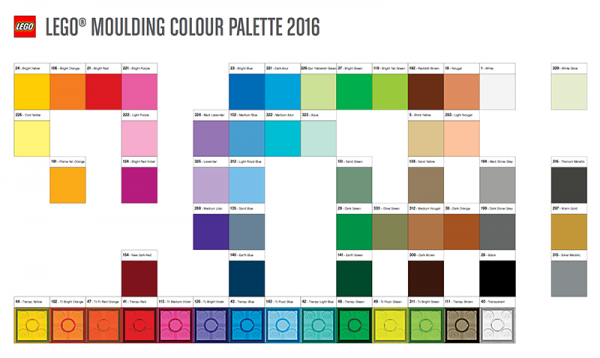
Official 2016 LEGO Color Palette includes 39 solid colors, 3 metallic colors, 1 glowing color, and 14 translucent colors.
How Color works?
Before we can understand the strengths and weaknesses of the LEGO color palette, it’s useful to understand how color works. You may recall that there are three “primary” colors of light: red, green, and blue. Your computer can create any color by mixing those three colors; when mixed in equal parts they create white light. This is why colors on your computer are often described as “RGB”, short for red, green, blue.
LEGO bricks are not made of light; they are made of plastic. Pigments are mixed in the right proportions to ensure that every LEGO brick is the right color. The color you see when looking at a LEGO brick is the color reflected by the plastic brick when a white light is pointed at it.
The reflected light is distributed across the visible spectrum, and the cones in our eyes (or the sensors in your camera) detect the light to determine the color which we seen. While digital cameras and computers describe colors using “RGB” values, we will use an easier to understand system called “HSL” (Hue, Saturation and Luminance) to explore the LEGO color palette.
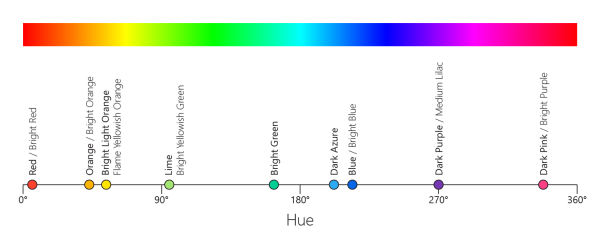
“Hue” is often used to mean color. Some common LEGO colors are shown in the line below the complete spectrum.
The difference between a vibrant red, yellow, green or blue is what people think of when they say “color”, but the underlying difference is that these colors have a different “hue”. (Hue is closely related to the frequency of visible light that we see.)

Blue LEGO Colors organized from least saturation to most saturation.
“Saturation” describes how pure a color is. Vibrant colors have a high “saturation. Grayish colors like “Sand Blue” have a low saturation. A pure white, black, or a neutral gray has no saturation at all.
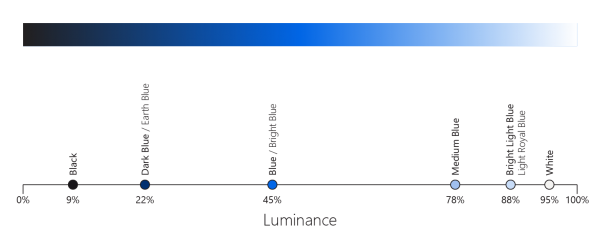
Saturated blue hues of LEGO organized by Luminance.
“Luminance” approximates the shade of gray you would see if you removed the saturation. For saturated colors, a high luminance results in a “pastel” or “light” color, medium luminance results in a “bright” color, and a low luminance results in a “dark” color.
It is worth noting that the LEGO “Black” is not a true black, but rather a very dark gray, and LEGO “White” is actually a light orangeish gray.
Organizing the LEGO Palette
By photographing every common LEGO color under controlled conditions, and calibrating the resulting photo using a neutral gray card, I extracted the RGB color for each brick, and converted those colors to HSL. This allows us to see the distribution of LEGO colors on various dimensions.

2016 LEGO color palette plotted by Saturation vs. Luminance.
By graphing each color in the LEGO color palette by saturation vs. luminance, you will see some logical groupings of the various colors. It also helps explain some of the differences between the names LEGO enthusiasts use to describe colors, and the official The LEGO Group names for each color:
- Bright – LEGO consistently labels many common colors as “Bright Red” or “Bright Blue” that most LEGO enthusiasts describe simply as Red or Blue. Bright colors have almost 100% saturation and around 50% luminance.
- Light – There are a number of colors with high luminance (around 90%) such as: Light Flesh (Light Nougat), Bright Light Blue (Light Royal Blue), Bright Light Yellow (Cool Yellow), Yellowish Green, Tan (Brick Yellow), and Light Aqua (Aqua). The naming isn’t very consistent, but “light” is the most common description.
- Dark / Earth – We also have a variety of dark colors with around 25% luminance including: Dark Green (Earth Green), and Dark Blue (Earth Blue) which both have high saturation, as well as Dark Brown which has low saturation.
- Sand – Colors such as Sand Green, Sand Blue, and Dark Tan (Sand Yellow) are very useful to LEGO builders even though they aren’t very common. Sand colors have around 50% luminance and below 50% saturation.
- White, Light Bluish Gray (Light Stone Gray), Dark Bluish Gray (Dark Stone Gray), and Black have very low saturation, and around 100%, 85%, 50% and 0% luminance respectively. If these colors had 0% saturation, they would be true neutral gray colors. They aren’t quite neutral, which is why we call the current colors “bluish gray” instead of just “gray”.

2016 LEGO color palette plotted by Hue vs. Luminance.
When we graph the colors in the LEGO color palette by hue vs. luminance, you can see that some hue values offer a lot of different colors, and other hue values such as pink, purple, green and red hues offer more limited selection.

Colors with an “orange” hue organized by Saturation vs. Luminance.
We find that there are a lot of colors available in the narrow range of orange hues. The selection is enhanced by the around 60% saturation Flesh, Light Flesh and Dark Flesh tones, even though those colors aren’t very common in basic bricks. LEGO also offers a good selection in the low-saturation range as well, such as Tan, Dark Tan, and Brown.

“Blue” hues organized by Saturation vs. Luminance.
Blue offers evenly distributed options ranging in luminance from Bright Light Blue (Light Royal Blue) all the way to Dark Blue (Earth Blue). Further, Sand Blue is one of the few low saturation colors in the LEGO color palette
Potential improvements
39 different colors is less than the original Nintendo NES video gaming console (which had 54 different colors), and a lot less than our modern devices that can display a nearly unlimited range of colors.
The natural desire to improve the color palette is to add dozens of new colors to fill in the existing gaps. An easy way to do this in an evenly distributed way would be to pick relevant hue values, and ensure that each hue offers a light, medium, bright, dark, and sand option. Unfortunately, it is safe to assume that the LEGO Group wants to maintain a small number of colors to reduce inventory and costs.
One way to improve the LEGO palette is by making the existing colors more consistent. Related colors would be shifted to have exactly the same hue despite different luminance and saturation values. It would be easier to build realistic models if you had a full range of colors from light to dark, as well as both bright and sand colors for each hue.
Another potential improvement is to use the same saturation/luminance values for colors with the same description. For example, all “bright” colors could have 100% saturation / 50% luminance, “light” colors could have 75% saturation / 90% luminance, and “sand” colors could have 25% saturation / 50% luminance.
One practical approach would be to remove a few colors that are very similar (such as tan vs. light flesh) and add options in other areas. For example, you could pick a small number of primary hues such as Red, Yellow/Tan, Orange/Flesh, Blue, and Green. These colors would have a full range Light, Medium, Bright, Dark, and Sand options. Secondary colors such as Pink, Purple, Lime, and Turquoise would remain, but would only be offered in a Bright and Light option. This would result in 25 primary colors, 8 secondary colors, white, light & dark gray, and black for a total of 37 colors, leaving room for special exceptions like Brown, which is an important color that doesn’t fit into the pattern.
To be clear, even a thoughtful change to the LEGO color palette is probably a bad idea. The LEGO Group learned a hard lesson in 2005 when they angered adult LEGO fans by changing from a yellowish gray to a bluish gray. That said, if they do decide to introduce more colors in the future, maybe they will be thoughtful about more closely matching the hues of other existing colors.
Side Note – Gray vs. Bley
In 2005 the LEGO Group made a number of cost cutting changes as part of their efforts to regain profitability. One of the changes was to retire many colors, and tweak a few of the colors to make the color palette more consistent and to address feedback from customers. One of the discoveries was that the old “Gray” and “Dark Gray” colors were not well liked by parents and kids as they have a subtle yellowish tint that appears dirty. Rather than shift to a completely neutral gray, they chose a slightly Bluish gray and “Bley” was born.
I created a couple images showing the differences between Old Gray and New Bluish Gray, to help explain these changes.
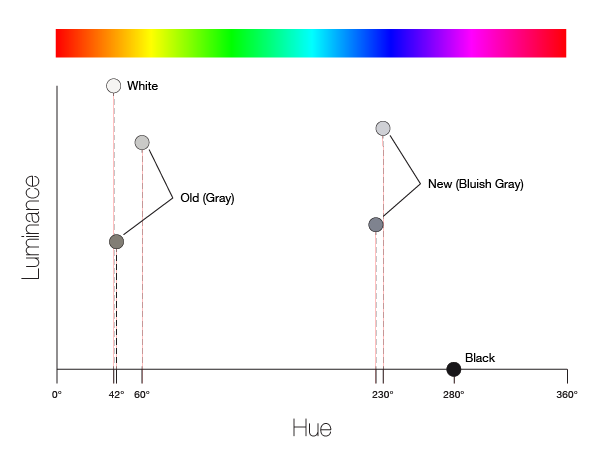
Hue vs. Luminance with Old and New Gray.
This illustration shows what makes Bluish Gray “blue” and why Old Gray is yellowish. It’s all in those small percentages of saturation. At 0% saturation, there is no color at all, so Hue no longer matters, but even at a value as small as 2-7%, the underlying hue shows through. The old gray colors have a hue near Yellow/Brown, and the new gray colors are near Blue on the Hue spectrum.
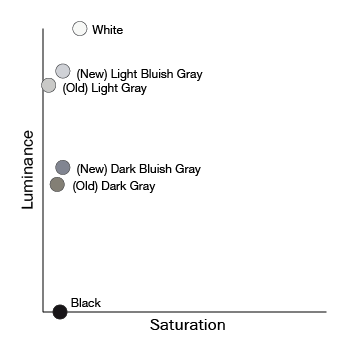
Hue vs. Saturation for Old and New Gray.
To state my bias outright, I would prefer if the White, Black and Grey colors in the LEGO color palette were completely neutral tones (having 0% saturation). Based on this goal alone, New gray is “worse” than old gray: (New) Light Bluish gray is 7% saturation while (Old) Light Gray was just 2%. (New) Dark bluish gray is also 7%, whereas (old) Dark Gray was 5% saturation.
Further Reading
The Changing Palette of LEGO: 1975-2014 (The Brothers Brick) – This article shows the changing distribution of colors from 1975 – 2014. There are a lot more colors today, but most striking is the huge percentage of LEGO elements which are Black, Light Bluish Gray, Dark Bluish Gray, and White (in that order). Those four colors alone amount to more than 50% of LEGO bricks produced.
LEGO® Colour Chart Reference – A brief history of the LEGO palette, including discussion of the huge number of colors used in the early 2000’s, followed by the consolidation to the current palette around 2005.
You may also enjoy these resources from LEGO Color archivist Ryan Howerter:
- LEGO Color reference spreadsheet – A great resource for translating between Official LEGO Color Names, ID’s, and more commonly used color names from BrickLink.
- Brick Colorstream – A photo gallery showing carefully captured photos of every known color.
- LEGO Color Timeline – a huge chart showing the year each color was introduced and retired.

I just wich there was a slight warm deviation from white, and cold ditto, making it possible to more easily achieve ‘dirty white’ builds, like whitewashed walls.
Very interesting article. However, the primary colours are actually red, yellow and blue. RGB is one of two colour formats used on computers and is strictly used for electronic display. Printed materials are created with the CMYK format, which stands for Cyan, Magenta, Yellow and Black, more actually replicating colour in the real world.
Karen,
I am knowledgeable on the differences between mixing pigments (RYB) versus mixing light colors (RGB) and with print (CMYK). I chose to use RGB within this article because it is more familiar for folks familiar with colors on computers.
All the time I saw that the colors in LEGO are pure coincidence, that they are chosen because they are “pretty”, and here I see that the selection of colors is a bit more advanced process.
Filling the gaps in the palette by filling missing hue ranges? Not sure if that is good advise. In nature, some hues are more often seen than others. And more importantly, Lego is an artistic representation of something, using approximations in shape and color. Working with a restricted set of shape and color would help to create builds unmistakably Lego.
Thank you for your work here. You have saved me a great deal of time.
What color does lego use for the wrinkles/creases/jawline?
This isn’t my area of expertise, but I believe the ink colors they use closely match the various brick colors. (So, on a light nougat colored head, it might have dark nougat creases.)
—Tom
Well, I thought that Lego colors is not a complicated issue until I read this 😉 Anyway, very interesting article. As for extending/changing color palette I guess it’s unlikely – it’s already quite big now and repeating situation with light gray/light bluish gray is looking for a trouble.
I think that you are correct to think that it’s unlikely to see a lot more colors, even though there are some prominent gaps in the color palette.
That said, we have seen two new “neon” colors in the last couple years (called “vibrant” by The LEGO Group)…
Absolutely fascinating article. I have recently become intrigued with the LEGO color names and palette, this was the perfect starting point. Thank you for all the work and visuals paired with the easy to understand explanations. The LEGO names make more sense now, even if I still prefer their more common BrickLink names in most cases.
The biggest surprise for me was just how big the difference in hue was between the old and new grays.
Most AFOLs prefer the BrickLink names, which are anywhere from identical to the official LEGO naming, to significantly less confusing. (P.S. Brick Yellow makes a bit more sense in Denmark – their homes really are built out of weird tan bricks.)
The transition from the yellowish greys to the bluish greys actually occurred (or at least began) in Q1 2004, including (but probably not limited to) the first wave of the 2004 Bionicle lineup.
What did you use for your HSL data source? Your values for the different grays seems more accurate than what I have found online elsewhere.
As an example: Ryan Howerter’s hex code for Old Light Gray is 8A928D which is HSL 143, 4%, 56%. This seems too green and too dark. Other sites list Old Light Gray as Pantone 422 C with a hex code of 9EA2A2 which is HSL 180, 2%, 63%. This is way too blue and still too dark.
Your HSL values for Old Light Gray of 60, 2%, ~80% seem much more true to life. This has me hope that the rest of your data is just as good. Would you be willing to post your color data set?
I extracted colors from a photograph that I took, which was then calibrated to neutral gray using a gray card. At the time, I did not have a more advanced color profiling system, but I now own an x-rite Color Checker Passport, and at some point in the future I plan to photograph the same selection of bricks using multiple cameras, all corrected using the gray card and custom profiles, and then finally averaging the RGB / HSL values.
The biggest challenge which will crop up next is that sRGB is too limited to reproduce many official LEGO colors.
Brilliant article, great work!
I have an x-rite Color Checker Passport as well, frankly, I hadn’t thought of using that to check the brick colors from a photo. I was searching for the values of Bley to paint a tabletop. I also like your idea of averaging out the cameras/photos.
Great site by the way!
Thank you! Your information was very helpful in understanding the color palette and why the colors are named as they are. Like Jeremy, I thought my gray bricks had yellowed with age!
I have Lego bricks from the early days (about 1960) to new. The color changes are most apparent in Red. The “basic” Red ranges from a really bright color to rather dull. I also have some bricks that have discolored over the years. The colors were not identical from the early days to the 1970s in Red. White seems to discolor the most over time, old blue bricks from when I was a kid in the late 1960s seems totally stable, there was a brief time when Yellow was slightly translucent it was so bright in color and the clear bricks from the 1960s are often really dull. Just some earlier time input.
I realize this is just practical info, not directly adding to your color palette information but I hoped it would be useful.
What a fun and informative read. Thanks!
I have sets from ~1982 (when I was just a young boy with my first Legos!) all the way to present day. And here I thought the yellowing gray bricks I owned were due to discoloration over time… ha! (Although, to be fair, yes, I’m sure there has been some discoloration over time since other older bricks in white, yellow, and red have all yellowed somewhat.)
I appreciated the hue/saturation/luminance breakdown in X-Y graphical format though – very very helpful.